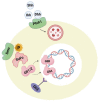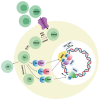Dysregulation of Multiple Signaling Neurodevelopmental Pathways during Embryogenesis: A Possible Cause of Autism Spectrum Disorder
- PMID: 33924211
- PMCID: PMC8074600
- DOI: 10.3390/cells10040958
Dysregulation of Multiple Signaling Neurodevelopmental Pathways during Embryogenesis: A Possible Cause of Autism Spectrum Disorder
Abstract
Understanding the autistic brain and the involvement of genetic, non-genetic, and numerous signaling pathways in the etiology and pathophysiology of autism spectrum disorder (ASD) is complex, as is evident from various studies. Apart from multiple developmental disorders of the brain, autistic subjects show a few characteristics like impairment in social communications related to repetitive, restricted, or stereotypical behavior, which suggests alterations in neuronal circuits caused by defects in various signaling pathways during embryogenesis. Most of the research studies on ASD subjects and genetic models revealed the involvement of mutated genes with alterations of numerous signaling pathways like Wnt, hedgehog, and Retinoic Acid (RA). Despite significant improvement in understanding the pathogenesis and etiology of ASD, there is an increasing awareness related to it as well as a need for more in-depth research because no effective therapy has been developed to address ASD symptoms. Therefore, identifying better therapeutic interventions like "novel drugs for ASD" and biomarkers for early detection and disease condition determination are required. This review article investigated various etiological factors as well as the signaling mechanisms and their alterations to understand ASD pathophysiology. It summarizes the mechanism of signaling pathways, their significance, and implications for ASD.
Keywords: Asperger’s syndrome; autism spectrum disorder; hedgehog signaling pathway; neuropathological alterations.
Conflict of interest statement
The authors declare no conflict of interest.
Figures



References
Publication types
MeSH terms
LinkOut - more resources
Full Text Sources
Other Literature Sources
Medical

